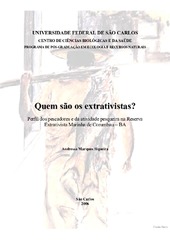Quem são os extrativistas? Perfil dos pescadores e da atividade pesqueira na Reserva Extrativista Marinha de Corumbau - BA
Abstract
The Extractive Reserve was initially created as a handling category proposal
around 1989, and in 2000 became a direct use conservation unit with the creation of SNUC
(National System of Conservation Units). Since then, it has been possible to observe an
increasing rise in the number of conservation units of this category, for whom the handling
plan must consider - at first instance human population and its exploitation forms. In
regards to this, the present work proposes to give an answer to the question who are the
extraction workers of the REM (Marine Extractive Reserve) of Corumbau , aiming at
granting and directing the above unit s Handling Plan And Multiple Use restructure. To so
proceed, social-economic and fishery aspects of the extraction workers were identified, by
means of structured and semi-structured questionnaires and analyses based on Shannon-
Wiener diversity, Bray-Curtis dissimilarity indexes, as well as Levins niche breadth and
overlap. Gathered socio-economic aspects allowed to verify that REM of Corumbau
fisherman is within the standards of Brazilian artisanal fishermen. His profile can be
defined as: professionally informal fisherman, male, indigenous color and descent, between
21 and 40 years of age, few school years and fishing as main activity. In what concerns the
characterization of fishing occupation, the canoe should be mentioned as the most used
form of navigation; the main fishery tackles were lines/hooks, gill nets and harpoons. The
Bray-Curtis index allowed the division of fishermen communities into three groups,
defined in a similarity decreasing order. Fishery activities diversity values varied from
medium to high. Nevertheless, niche measures showed tendencies towards specialization
and high overlap, due to the predominance of fishing tackles such as lines/hooks, gill nets
and harpoons in all studied communities.
